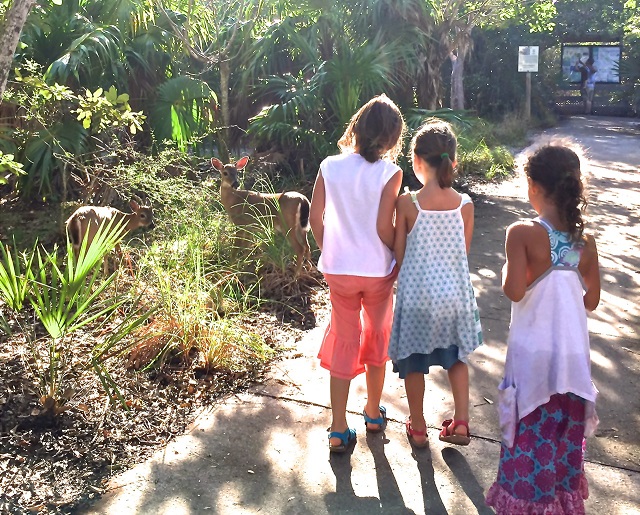Key Deer: The Endangered Darlings of the Florida Keys and What We Can Do to Protect Them

Key deer may be tiny in size, but this endangered species is big on the list of well-loved wildlife. If the diminutive deer exclusive to the Florida Keys has somehow eluded you, it’s time to make your way to the third annual Outdoor Fest, set for Saturday, March 10th through Saturday, March 17th and hosted by US Fish and Wildlife Service’s Florida Keys National Wildlife Refuges Complex and their Friends group, Florida Keys Wildlife Society. With a Wildlife Fair at their new Big Pine Key Nature Center and a Run with Deer 5k just some of their many offerings, you’re sure to sight this miniature but magnificent creature.
The smallest cousins of white-tailed deer, Key deer migrated from the mainland during the latest Ice Age when sea levels were much lower, their size shrinking over time as they adapted to the limited resources and warmer temperatures on these small island habitats. Near extinction from habitat destruction and poaching in the 1950s led to a federal recovery effort and was soon backed by the 1957 establishment of National Key Deer Refuge, helping secure their survival. Since then, the early herd of 25 deer has rebounded to upwards of 800-1200 animals spread throughout much of the Lower Keys.
Even still, natural and human impacts like parasites, hurricanes, car collisions, poachers, climate change, rising sea levels, disease, dogs, and close proximity to homes and roads are ever-present threats. The last two years have been especially challenging with the New World screwworm outbreak and the direct hit of Category 4 Hurricane Irma within the National Key Deer Refuge. Considering this, the Key deer population has proven to be surprisingly resilient. Population estimates post-Irma ranged from 800-1200 deer. Deer habitat continues to recover as well, and the refuge will continue to monitor both the population of deer and the health of the habitat into the future.
However, habituation to humans continues to be a challenge.
“The reason they’ve lost their natural wariness around people is because they have been fed,” says Refuge Ranger and Outreach Coordinator Kristie Killam. “Any deer that approaches you is likely looking for a free handout.”
Killam is part of a small team of refuge managers, biologists, law enforcement officers, maintenance staff, volunteers, and the refuge friends group Florida Keys Wildlife Society that welcome over 100,000 visitors to the four Florida Keys National Wildlife Refuges annually, doing everything they can to help protect and conserve the creatures and habitats found there.
“Education and awareness is key,” says Killam. “As is stewardship— planting native plants, responsible pet ownership, not feeding wildlife, ethical wildlife viewing, driving the speed limit, and leaving no trace— these are just a few of the ways people can do their part.”
When it comes to Key deer, there are some simple but strict rules to follow:
1). No matter how cute they are or how close they may get, forget about petting them. You are not a deer whisperer and they are (federally protected) wild animals. Touching, harassing, or possessing one is a federal offense.
2). Slow down while driving between Sugarloaf Keys east to Bahia Honda, with extra caution in Big Pine Key.
3) Landscape with natives. Resist the urge to offer them whatever it is you happen to be eating when you see them, and know the only “feeding” that’s legal is to leave them be and landscape with the ecosystem’s native plants to create a natural habitat. Berries, leaves, and flowers from more than 150 native plants and trees— including palms, gumbo limbo, strangler figs, blackbead, blolly, black torch, sea grape, and pigeon plum – make up the Key deer diet.
4). Remember that a fed deer can lead to a dead deer.
“From a health perspective, feeding them human foods or foods they aren’t used to eating can make them sick,” says Killam. “In the case of cracked corn or dog food, it can kill them. Feeding them also habituates them to people, making them less wary around vehicles, dogs, trash, and even makes them susceptible to poaching.”
With over 9,200 acres of habitat within the Key deer range, “Key deer wander all the habitats in the National Key Deer Refuge, including pine rocklands, hardwood hammocks, fresh and saltwater wetlands, mangroves, and sometimes along beaches,” says Killam.
“Please help them remain wild and independent by observing them from a distance and not feeding them.”
To learn more about Key deer and their natural habitat, check out the upcoming Outdoor Fest: visit floridakeyswildlifesociety.org, contact Refuge Ranger Kristie Killam at 305.304.9625, or email Nancy or Jan at flkeysoutdoorfest@gmail.com . Brought to you in part by the Monroe County Tourist Development Council.

